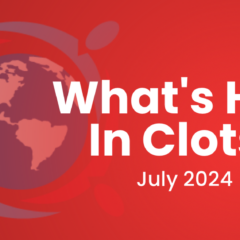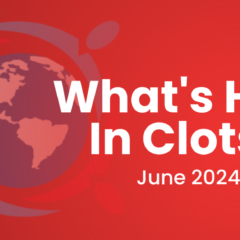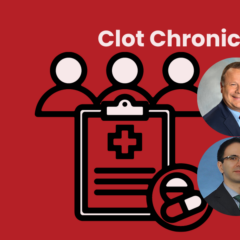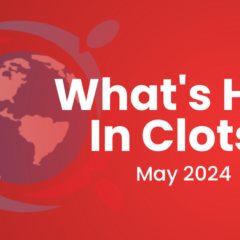Last updated on
Clot Chronicles: Anticoagulation in COVID-19 — What We’ve Learned One Year Later
Hi, this is Dr. Behnood Bikdeli from the Cardiovascular Medicine Division at Brigham and Women’s Hospital, also from the Center for Outcomes Research and Evaluation at Yale and the Cardiovascular Research Foundation in New York. I’m here today on Clot Chronicles to discuss updates on anticoagulation in the setting of COVID-19.
Since last year, our understanding of the disease pathophysiology and epidemiology has improved. Some of the studies are now showing that the incidence of blood clots in patients with COVID-19 may be a little less than what we had perceived before. And nevertheless, thrombosis continues to remain an important concern in these patients. And it is in this context that I think it’s time to take a quick look at the studies to show what the optimal anticoagulation regimen could be across the spectrum of disease severity in patients with COVID-19.
So, we have four groups of patients to think about: outpatients, patients on the floor, patients who are so sick that require ICU level of care, and ultimately people who are recovering and getting discharged from the hospital but might still be at risk of blood clots and so need some form of prophylaxis. So, we did a systematic study that was published in JACC a couple of weeks ago trying to understand what the existing evidence for anticoagulation in COVID-19 is, based off of randomized trials. And we were able to identify 75 registered randomized trials across the spectrum of severity of illness for COVID-19. Out of them, a few have shared either preliminary or final results, and I’ll be glad to share them with you momentarily.
So, in the subset of outpatients that I was discussing first, the only study that has come out so far is in preprint for a randomized trial of sulodexide, which is basically an oral heparin-based regimen from Mexico in which over 240 patients were randomized to sulodexide versus placebo. And the study suggested that use of sulodexide compared with placebo was associated with a reduction in the need for hospitalization or requirement for treatment with oxygen. The full results in peer-reviewed literature still are not available, and we remain hopeful that we’ll get more details soon.
For the patients who are in the wards, there are no published fully available randomized trials. There are many randomized trials that are ongoing; most of them are trying heparin-based regimens, some of them are using oral anticoagulants, a few of them are even trialing antiplatelet agents. The only results that are currently available are preliminary results from the multiplatform trial inclusive of REMAP-CAP, ACTIV-4, and ATTACC, which suggested there might be a reduction in the need for organ support for people randomized to fully therapeutic anticoagulation compared with prophylactic-dose anticoagulation. The full results are not available, and the existing data were not adjudicated. So, we all remain very excited to see the final results, but also the results of several other ongoing randomized trials in hospitalized floor patients with COVID-19.
The third group that we can talk about is hospitalized patients in the ICU. From the same multiplatform trial that I was discussing—inclusive of REMAP-CAP, ACTIV-4, and ATTACC—a preprint full text manuscript was recently disseminated, which indicates that use of fully therapeutic anticoagulation compared with standard prophylaxis, this time around in ICU patients, did not show any evidence of benefit. And there was some suggestion for increased risk of bleeding events, so we remain committed to see the full results in peer-reviewed literature. But until then, these results were not encouraging for fully therapeutic empiric anticoagulation in critically ill patients.
And now, it’s also time to talk briefly about the INSPIRATION randomized study, which I was fortunate to be the joint principal investigator of. In INSPIRATION, nearly 600 patients with COVID-19 requiring ICU admission were randomized to receive intermediate-dose anticoagulation versus standard-dose prophylaxis with heparin-based regimens for a primary outcome of venous or arterial thrombosis, treatment with ECMO, or all-cause mortality.
The results were published a few days ago in JAMA and did not show any signal for benefit with intermediate-dose anticoagulation compared with standard prophylaxis either for the primary outcome or several secondary endpoints that we were looking at, and the results were consistent across subgroups. So, the totality of evidence that we have at the moment does not suggest that escalated-dose empiric anticoagulation confers benefit in ICU patients. Again, several studies are still ongoing, including some randomized trials for fibrinolytic therapy, and the results of those trials will be very informative as well.
The last and fourth group of patients that I wanted to quickly touch upon would be people who are in the post-discharge state. Data from the era before COVID-19 was highly suggestive that in patients who are early after discharge, there was a period of increased risk, particularly within the first 3 to 6 weeks after discharge. In this context, several investigators have been hypothesizing that maybe patients with COVID-19 will also benefit from extended-duration prophylaxis.
As of now, none of the studies have been completed, and we await the full results of the ongoing randomized trials. However, the results of some of the interesting observational studies that have come out suggest that maybe the event rates for symptomatic venous thrombosis is a little less in the post-discharge setting compared with what we initially were concerned about. Again, the results of additional studies, including the multicenter CORONA-VTE and other observational studies, will help us understand the epidemiology more effectively, and the results of randomized trials will be able to help guide us.
This was Dr. Bikdeli signing off for Clot Chronicles. Thank you.



